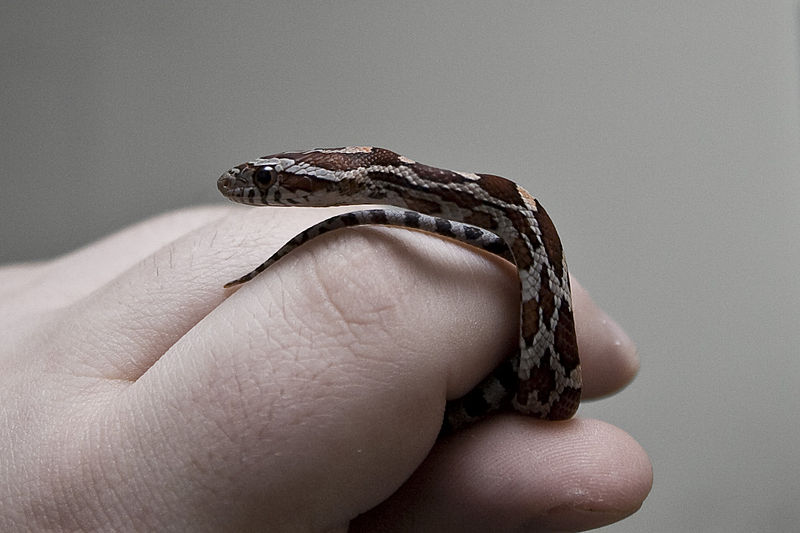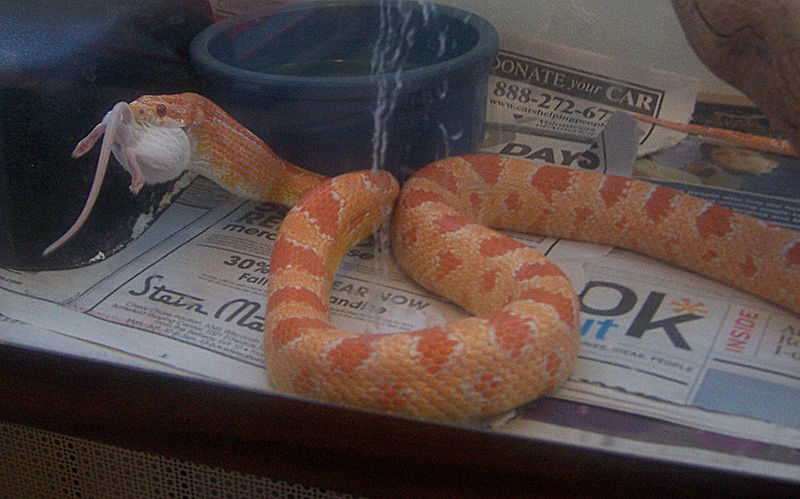 Also known as the Red Rat Snake, the Corn Snake (Pantherophis guttata), is one of North America’s most beautifully-patterned reptiles, and the world’s most popular serpent pet. Corn Snakes figured prominently in the development of American snake-keeping, and their history is tied up with the legendary Carl Kauffeld and his famous collecting site, Okeetee, South Carolina. My own history leads me to Corn Snakes as well…I was in awe of Mr. Kauffeld as a child, and in later years I was the consultant for the renovation of his beloved reptile house at the Staten Island Zoo. So, despite having crossed paths with hundreds of species, I reserve a special fondness for these interesting, undemanding beauties.
Also known as the Red Rat Snake, the Corn Snake (Pantherophis guttata), is one of North America’s most beautifully-patterned reptiles, and the world’s most popular serpent pet. Corn Snakes figured prominently in the development of American snake-keeping, and their history is tied up with the legendary Carl Kauffeld and his famous collecting site, Okeetee, South Carolina. My own history leads me to Corn Snakes as well…I was in awe of Mr. Kauffeld as a child, and in later years I was the consultant for the renovation of his beloved reptile house at the Staten Island Zoo. So, despite having crossed paths with hundreds of species, I reserve a special fondness for these interesting, undemanding beauties.
Recent Name and Classification Changes
The taxonomy, or classification, of the Corn Snake and its relatives has recently been revised. All have been moved from the genus Elaphe to Pantherophis; several species have been combined, and new ones have been described. We are left with the following (please see article below for details):
Eastern Corn Snake (the species most often kept as a pet)
Slowinski’s Corn Snake (limited to Louisiana and Eastern Texas, and named for herpetologist Joe Slowinski, who died of snakebite at age 38; please see article below)
Eastern Ratsnake (formerly the Black Ratsnake, and now incorporating the Yellow, Everglades and Texas Ratsnakes)
Western Ratsnake
Midland or Gray Ratsnake
Great Plains Ratsnake
Baird’s Ratsnake
Eastern Fox Snake
Western Fox Snake
Natural History

Corn Snakes frequent forest edges, overgrown fields and farms, and often take up residence in abandoned buildings. Typical prey for these powerful constrictors includes chipmunks, mice and voles, but they also climb well and sometimes take nestling birds and bats.
The name “Corn Snake” may have arisen due to their habit of hunting rodents in corn fields and barns, or to the pattern of the belly scales, which resembles dried “Indian corn”.
Corn Snakes as Pets
Ideal for beginners yet interesting enough for advanced hobbyists, Corn Snakes may live for over 20 years, are easy to handle and breed, and can be kept in modestly-sized terrariums…truly an ideal reptile pet. Breeders have developed over 25 unique color phases, as well as hybrids with King, Gopher and other Rat Snakes.
Fox Snakes and other species in the genus Pantherophis, listed above, may be kept in a similar manner to the Corn Snake. Please write in for detailed information.
Housing
Setting up the Terrarium
Hatchlings may be raised in 5-10 gallon aquariums. An average-sized adult measures 2.5 to 4 feet in length (exceptional individuals can exceed 5 feet) and may be kept in a 20-55 gallon tank.
The screen top must be secured with clips, as all snakes are escape artists.
 Stout, well-anchored branches or rock ledges can be added as basking sites. A hide box should always be available, as even long-term pets will be stressed if forced to remain in the open.
Stout, well-anchored branches or rock ledges can be added as basking sites. A hide box should always be available, as even long-term pets will be stressed if forced to remain in the open.
Substrate
Newspapers or washable terrarium liners work well as substrates. Douglas fir, aspen bedding and dead leaves allow for easy “spot cleaning” and lend a naturalistic touch. However, wood chips can lodge in the mouth during feeding; feed your snake in a bare-bottomed enclosure to prevent this.
Heat and Light
Corn Snakes fare best in a temperature range of 77-82 F; night-time temperatures can be allowed to drop to 70 F or so. An incandescent bulb should be used to create a basking spot of 90 F.
Large enclosures are necessary if a thermal gradient (areas of different temperatures) is to be established. Thermal gradients, critical to good health, allow snakes to regulate their body temperature by moving from hot to cooler areas.
A ceramic heater or red/black reptile “night bulb” can be used to provide heat after dark and will also enable you to view your pet’s nocturnal activities.
Corn Snakes do not require UVB exposure.
Feeding
 Adult Corn Snakes readily accept pre-killed mice. Hatchlings can usually handle pink mice, but particularly small individuals may need sectioned pinkies at first.
Adult Corn Snakes readily accept pre-killed mice. Hatchlings can usually handle pink mice, but particularly small individuals may need sectioned pinkies at first.
Youngsters should be fed once weekly; adults do fine with a meal each 7-10 days. Vitamin/mineral supplements are not necessary.
Water for drinking and soaking must always be available. Bowls should be filled to a point where they will not overflow when the snake curls up within, as damp conditions will lead to fungal infections of the skin and other health problems.
Breeding
The Corn Snake was the firstUSspecies to be captive-bred in large numbers, and remains an excellent introduction to snake breeding. Females produce clutches of 8-26 eggs, sometimes twice yearly, and the 8 – 11 inch long hatchlings are not difficult to rear. Please see the article below for further information.
Further Reading
Corn Snake History, Breeding and Color Phases
Carl Kauffeld and American Snake Keeping
Herpetologist Joe Slowinski, Obituary
Corn Snake Hatchling image referenced from wikipedia and originally posted by John Stone
 That Reptile Blog – Reptile, Amphibian and Exotic Pet Care and Information
That Reptile Blog – Reptile, Amphibian and Exotic Pet Care and Information


